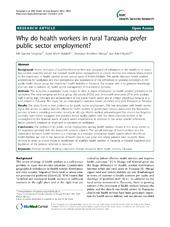| dc.contributor.author | Songstad, Nils Gunnar | en_US |
| dc.contributor.author | Moland, Karen Marie | en_US |
| dc.contributor.author | Massay, Deodatus Amadeus | en_US |
| dc.contributor.author | Blystad, Astrid | en_US |
| dc.date.accessioned | 2013-01-09T11:50:35Z | |
| dc.date.available | 2013-01-09T11:50:35Z | |
| dc.date.issued | 2012-04-05 | eng |
| dc.Published | BMC Health Services Research 2012, 12:92 | eng |
| dc.identifier.issn | 1472-6963 | |
| dc.identifier.uri | https://hdl.handle.net/1956/6256 | |
| dc.description.abstract | Background: Severe shortages of qualified health workers and geographical imbalances in the workforce in many low-income countries require the national health sector management to closely monitor and address issues related to the distribution of health workers across various types of health facilities. This article discusses health workers’ preferences for workplace and their perceptions and experiences of the differences in working conditions in the public health sector versus the church-run health facilities in Tanzania. The broader aim is to generate knowledge that can add to debates on health sector management in low-income contexts. Methods: The study has a qualitative study design to elicit in-depth information on health workers’ preferences for workplace. The data comprise ten focus group discussions (FGDs) and 29 in-depth interviews (IDIs) with auxiliary staff, nursing staff, clinicians and administrators in the public health sector and in a large church-run hospital in a rural district in Tanzania. The study has an ethnographic backdrop based on earlier long-term fieldwork in Tanzania. Results: The study found a clear preference for public sector employment. This was associated with health worker rights and access to various benefits offered to health workers in government service, particularly the favourable pension schemes providing economic security in old age. Health workers acknowledged that church-run hospitals generally were better equipped and provided better quality patient care, but these concerns tended to be outweighed by the financial assets of public sector employment. In addition to the sector specific differences, family concerns emerged as important in decisions on workplace. Conclusions: The preference for public sector employment among health workers shown in this study seems to be associated primarily with the favourable pension scheme. The overall shortage of health workers and the distribution between health facilities is a challenge in a resource constrained health system where church-run health facilities are vital in the provision of health care in rural areas and where patients tend to prefer these services. In order to ensure equity in distribution of qualified health workers in Tanzania, a national regulation and legislation of the pension schemes is required. | en_US |
| dc.language.iso | eng | eng |
| dc.publisher | BioMed Central | eng |
| dc.relation.ispartof | <a href="http://hdl.handle.net/1956/6257" target="blank">Health worker motivation in a low-income context. The case of rural health services in Tanzania</a> | eng |
| dc.rights | Attribution CC BY | eng |
| dc.rights.uri | http://creativecommons.org/licenses/by/2.0 | eng |
| dc.title | Why do health workers in rural Tanzania prefer public sector employment? | en_US |
| dc.type | Peer reviewed | |
| dc.type | Journal article | |
| dc.description.version | publishedVersion | en_US |
| dc.rights.holder | Copyright 2012 Songstad et al; licensee BioMed Central Ltd. | |
| dc.identifier.doi | https://doi.org/10.1186/1472-6963-12-92 | |
| dc.identifier.cristin | 944998 | |

